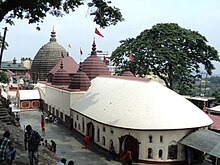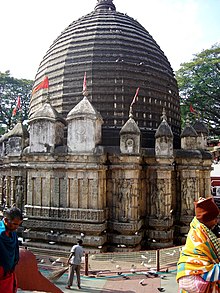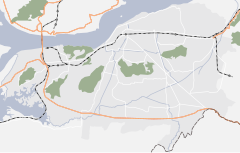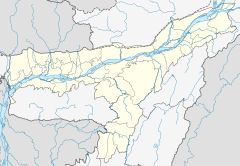Kamakhya Temple
| Kamakhya Temple | |
|---|---|
 Kamakhya Temple | |
| Religion | |
| Affiliation | Hinduism |
| Deity | Kamakhya |
| Festivals | Ambubachi Mela |
| Location | |
| Location | Nilachal Hill, Guwahati |
| State | Assam |
| Country | India |
| Geographic coordinates | 26°09′59″N 91°42′20″E / 26.166426°N 91.705509°E |
| Architecture | |
| Type | Nilachal type |
| Creator | Mlechchha dynasty.[1] Rebuilt by Koch King Nara Narayan and Ahom kings |
| Completed | 9th-17th century[2] |
| Specifications | |
| Temple(s) | 6 |
| Monument(s) | 8 |
| Website | |
| www | |

| Part of a series on |
| Shaktism |
|---|
 |
|
|
The Kamakhya Temple at Nilachal hills in Guwahati, Assam is one of the oldest and most revered centres of Tantric practices,[3] dedicated to the goddess Kamakhya. The temple is the center of the Kulachara Tantra Marga and the site of the Ambubachi Mela, an annual festival that celebrates the menstruation of the goddess.[4] Structurally, the temple is dated to the 8th-9th century with many subsequent rebuildings[5]—and the final hybrid architecture defines a local style called Nilachal.[6] It is also one among the oldest 4 of the 51 pithas in the Shakta tradition.[7][8] An obscure place of worship for much of history it became an important pilgrimage destination, especially for those from Bengal, in the 19th century during colonial rule.[9]
Originally an autochthonous place of worship of a local goddess where the primary worship of the aniconic yoni set in natural stone continues till today,[10] the Kamakya Temple became identified with the state power when the Mleccha dynasty of Kamarupa patronised it first, followed by the Palas, the Koch, and the Ahoms.[11] The Kalika Purana, written during the Pala rule, connected Naraka, the legitimizing progenitor of the Kamarupa kings, with the goddess Kamakhya representing the region and the Kamarupa kingdom.[12]
It has been suggested that historically the worship progressed in three phases—yoni under the Mlechhas, yogini under the Palas and the Mahavidyas under the Kochs.[13] The main temple is surrounded in a complex of individual temples dedicated to the ten Mahavidyas of Saktism, namely, Kali, Tara, Tripura Sundari, Bhuvaneshwari, Bhairavi, Chhinnamasta, Dhumavati, Bagalamukhi, Matangi and Kamalatmika.[14] Among these, Tripurasundari, Matangi and Kamala reside inside the main temple whereas the other seven reside in individual temples.[15] Temples for individual Mahavidyas together as a group, as found in the complex, is rare and uncommon.[16]
In July 2015, the Supreme Court of India transferred the administration of the Temple from the Kamakhya Debutter Board to the Bordeuri Samaj.[17]
Description
[edit]
The current structural temple and the rock-cut sculpture strewn in the vicinity indicate that the temple has been built and renovated many times in the period 8th–9th, 11th–12th, 13th–14th centuries and even later.[5] The current form, from the 16th century has given rise to a hybrid indigenous style that is sometimes called the Nilachal type: a temple with a hemispherical dome on a cruciform base.[6]
Shikhara and garbhagriha
[edit]The shikhara over the garbhagriha has a pancharatha plan[18] that rests on plinth moldings that are similar to the Surya Temple at Tezpur. On top of the plinths are dados from a later period which are of the Khajuraho or the Central Indian type, consisting of sunken panels alternating with pilasters.[19] The panels have delightful sculptured Ganesha and other Hindu gods and goddesses.[20] Though the lower portion is of stone, the shikhara in the shape of a polygonal beehive-like dome is made of brick, which is characteristic of temples in Kamrup.[21] The shikhara is circled by a number of minaret inspired angashikaras of Bengal type charchala.[22]
The inner sanctum within the shikhara, the garbhagriha, is below ground level and consists of no image but a rock fissure in the shape of a yoni (female genital):
The garbhagriha is small, dark and reached by narrow steep stone steps. Inside the cave there is a sheet of stone that slopes downwards from both sides meeting in a yoni-like depression some 10 inches deep. This hollow is constantly filled with water from an underground perennial spring. It is the vulva-shaped depression that is worshiped as the goddess Kamakhya herself and considered as most important pitha (abode) of the Devi.[23]
Calanta, Pancharatna, and Natamandir
[edit]The temple consists of three additional chambers. The first to the west is the calanta, a square chamber of type atchala (similar to the 1659 Radha-Vinod Temple of Bishnupur[24]). The entrance to the temple is generally via its northern door, that is of Ahom type dochala. It houses a small movable idol of the Goddess, a later addition, which explains the name.[25] The walls of this chamber contain sculpted images of Nar Narayana, related inscriptions and other gods.[26]
The natamandira extends to the west of the pancharatna with an apsidal end and ridged roof of the Ranghar type Ahom style. Its inside walls bear inscriptions from Rajeswar Singha (1759) and Gaurinath Singha (1782), which indicate the period this structure was built.[27] The outer wall has stone sculptures from an earlier period embedded in high relief.[28]
History
[edit]Site of Kamakhya
[edit]Historians have suggested that the Kamakhya temple was likely an ancient sacrificial site for Khasi and Garo peoples and that the name originates in the Khasi goddess, Ka Meikha (literally: old-cousin-mother);[29] and these claims are supported by the folklores of these very peoples.[30] The traditional accounts from Kalika Purana (10th century) and the Yogini Tantra too record that the goddess Kamakhya is of Kirata origin,[31] and that the worship of Kamakhya predates the establishment of Kamarupa (4th century CE).[32]
Ancient
[edit]The earliest historical dynasty of Kamarupa, the Varmans (350–650), as well as Xuanzang, a 7th-century Chinese traveler, do not mention Kamakhya; and it is assumed that the worship at least till that period was Kirata-based beyond the brahminical ambit.[33] The Hevajra Tantra, one of the oldest Buddhist tantras probably from the 8th century, makes a reference to Kamarupa as a pitha,[34] whereas the first epigraphic notice of the goddess Kamakhya is found in the 9th-century Tezpur plates of Vanamalavarmadeva of the Mlechchha dynasty.[35] Art historians suggest that the archaeological remains and the lower strata of the temple indicate an older structure that could be as old as 5th- to 7th-century.[36] The importance to Kamakhya that the Mlechchha dynasty gave it suggests that they either constructed or reconstructed it.[1] From the moldings of the plinth and the bandhana, the original temple was clearly of Nagara type possibly of the Malava style.[37]
Medieval
[edit]There is a tradition that the temple was destroyed by Kalapahar, a general of Sulaiman Karrani (1566–1572). Since the date of reconstruction (1565) precedes the possible date of destruction, and since Kalapahar is not known to have ventured so far to the east, it is now believed that the temple was destroyed not by Kalapahar but during Hussein Shah's invasion of the Kamata kingdom (1498).[38]
The ruins of the temple was said to have been discovered by Vishwasingha (1515–1540), the founder of the Koch dynasty, who revived worship at the site; but it was during the reign of his son, Nara Narayan (1540–1587), that the temple reconstruction was completed in 1565. According to historical records and epigraphic evidence, the main temple was built under the supervision of Chilarai.[39] The reconstruction used material from the original temples that was lying scattered about, some of which still exists today. After two failed attempts at restoring the stone shikhara Meghamukdam, a Koch artisan, decided to take recourse to brick masonry and created the current dome.[40] Made by craftsmen and architects more familiar with Islamic architecture of Bengal, the dome became bulbous and hemispherical which was ringed by minaret-inspired angashikharas.[6] Meghamukdam's innovation—a hemispherical shikhara over a ratha base—became its own style, called Nilachal-type, and became popular with the Ahoms.[41]
Banerji (1925) records that the Koch structure was further built over by the rulers of the Ahom kingdom.[42][43] with remnants of the earlier Koch temple carefully preserved.[44][45] By the end of 1658, the Ahoms under king Jayadhvaj Singha had conquered the Kamrup and after the Battle of Itakhuli (1681) the Ahoms had uninterrupted control over the temple. The kings, who were supporters of Shaivite or Shakta continued to support the temple by rebuilding and renovating it.[46]

Rudra Singha (1696–1714) invited Krishnaram Bhattacharyya, a famous mahant of the Shakta sect who lived in Malipota, near Santipur in Nadia district, promising him the care of the Kamakhya temple to him; but it was his successor and son Siba Singha (1714–1744), on becoming the king, who fulfilled the promise. The Mahant and his successors came to be known as Parbatiya Gosains, as they resided on top of the Nilachal hill. Many Kamakhya priests and modern Saktas of Assam are either disciples or descendants of the Parbatiya Gosains, or of the Nati and Na Gosains.[48]
Worship
[edit]
The Kalika Purana, an ancient work in Sanskrit, describes Kamakhya as the yielder of all desires, the young bride of Shiva, and the giver of salvation. Shakti is known as Kamakhya. Tantra is basic to worship, in the precincts of this ancient temple of mother goddess Kamakhya.
The worship of all female deity in Assam symbolizes the "fusion of faiths and practices" of Aryan and non-Aryan elements in Assam.[49] The different names associated with the goddess are names of local Aryan and non-Aryan goddesses.[50] The Yogini Tantra mentions that the religion of the Yogini Pitha is of Kirata origin.[51] According to Banikanta Kakati, there existed a tradition among the priests established by Naranarayana that the Garos, a matrilineal people, offered worship at the earlier Kamakhya site by sacrificing pigs.[52] The tradition of sacrifices continue today with devotees coming every morning with animals and birds to offer to the goddess.[53]
The goddess is worshipped according to both vamachara ("left-hand path") as well as the dakshinachara ("right-hand path") modes of worship.[54] Offerings to the goddess are usually flowers, but might include animal sacrifices. In general female animals are exempt from sacrifice, a rule that is relaxed during mass sacrifices.[55]
Legends
[edit]According to the Kalika Purana, Kamakhya Temple denotes the spot where Sati used to retire in secret for a carnal union with Shiva, and it was also the place where her yoni (genitals and womb) fell after Shiva's tandav (dance of destruction) with the corpse of Sati.[56] This is not corroborated in the Devi Bhagavata, which lists 108 places associated with Sati's body, though Kamakhya finds a mention in a supplementary list.[57]
The Yogini Tantra, a latter work, ignores the origin of Kamakhya given in Kalika Purana and associates Kamakhya with the goddess Kali and emphasizes the creative symbolism of the yoni.[58]
Due to a legendary curse by the Goddess, members of the Koch Bihar royal family do not visit the temple and avert their gaze when passing by.[59]
Festivals
[edit]
As a centre for Tantra worship, this temple attracts thousands of tantra devotees in an annual festival known as the Ambubachi Mela. Another annual celebration is the Manasha Puja. Durga Puja is also celebrated annually at Kamakhya during Navaratri in the autumn. This five-day festival attracts several thousand visitors.[60]
- Gallery
-
The adhisthana of the Kamakhya Temple
-
The adhisthana of the Kamakhya temple indicates that the original temple was of Nagara style
-
Lajja Gauri[61] on the northern wall of the Natmandira.
See also
[edit]Notes
[edit]- ^ a b "Along with the inscriptional and literary evidence, the archaeological remains of the Kamakhya temple, which stands on top of the Nilacala, testify that the Mlecchas gave a significant impetus to construct or reconstruct the Kamakhya temple." (Shin 2010:8)
- ^ "it is certain that in the pit at the back of the main shrine of the temple of Kamakhya we can see the remains of at least three different periods of construction, ranging in dates from the eighth to the seventeenth century A.D." (Banerji 1925, p. 101)
- ^ "Seated on top of Nilacala hill on the banks of the Brahmaputra river in the state of Assam, Northeast India, Kamakhya temple is one of the oldest and most revered centres of Tantric practice in South Asia." (Urban 2019:256)
- ^ "Today, Kamakhya remains both a vibrant centre of Tantric practice as the seat of a living lineage of the Kulacara Tantra Marga and a popular pilgrimage destination as the locus of major festivals such as Ambuvacī Mela." (Urban 2019:257)
- ^ a b (Shin 2010:5f)
- ^ a b c (Sarma 1988:124)
- ^ (Urban 2008, p. 500)
- ^ The four oldest of [the sakta pithas] are Kamarupa in the northeast, Uddiyana in the north (in the Swat Valley of modern Pakistan), Purnagiri in the south (precise location unknown) and Jalandhara (near Kangra in Himachal Pradesh)" (Urban 2019:261)
- ^ " As Ramos persuasively argues in her study of the sakta pithas, the once obscure and remote region of Assam became increasingly important to many Indians (particularly Bengalis) during the nineteenth century amidst the politics of British colonial rule." (Urban 2019:265)
- ^ (Shin 2010:3)
- ^ "Long after the collapse of the Pala dynasty, Kamakhya continued to be closely tied to kingship and territory. The temple was rediscovered in the sixteenth century by the Koch king Visva Singha (1515–40) and then rebuilt in its present form by his son Naranarayana (1540–86). Later, the most powerful of the Ahom kings, such as Rudra Singha (1697–1714) and Siva Singha (1714 _ –44), continued to patronise Sakta Tantra as the 'cult of strength'" (Urban 2019:265)
- ^ "The story of Naraka is far more elaborate in KP in which his relationship with the goddess Kamakhya is heavily emphasized... Here the goddess is not merely a local goddess but a representative deity of the region and kingdom of Kamarupa..." (Shin 2010:10)
- ^ Shin (2010, p. 3)
- ^ "The group of Mahavidyas, ..., is the most comprehensive Sakta Tantric pantheon." (Shin 2010:4)
- ^ (Shin 2010, p. 4)
- ^ Shin (2010, p. 4)
- ^ Kashyap, Samudra Gupta (14 July 2015), As SC directs the return of old order at Kamakhya, looking back, and ahead
- ^ (Sarma 1983, p. 47)
- ^ (Banerji 1925, p. 101)
- ^ "Kamakhya temple". Archived from the original on 18 March 2006. Retrieved 12 September 2006.
- ^ (Banerji 1925, p. 100)
- ^ (Sarma 1988, p. 124)
- ^ (Shin 2010, p. 5)
- ^ "ASI, Kolkata Circle".
- ^ "There is a mobile (calanta) image of Kamakhya at the outskirt of the cave", (Goswami 1998:14)
- ^ "Kamakhya". Retrieved 12 September 2006.
- ^ a b "The date of the (Natyamandira) is not known; but it possible pertains to the period of the two inscriptions pinned to the inner wall of its wall: one of Rajesshvarasimha, 1681 Saka/1759 AD and the other to Gaurinathasimha, 1704 Saka/1782 AD." (Neog 1980:315ff)
- ^ a b "(The Nrityamandira's) outer surfaces are decorated with figures in high relief as in a gallery. They include a wide range of subjects ranging from gods and goddesses to Ganas, Betalas and other demigods. The walls have niches with cusped arches to hold these pieces in rows separated by pilasters at regular intervals." (Das Gupta 1959:488)
- ^ "Many historians have suggested that Kamakhya herself may have originally been a tribal goddess and that Nilachal hill may have been a sacrificial site for nearby peoples such as the Khasis and the Garos. Some trace the name itself to the Khasi goddess Ka Meikha or 'old cousin mother'." (Urban 2009:46)
- ^ "To this day, in fact, many Khasi and Garo folk tales claim that Kamakhya was originally a site of their own deities." (Urban 2009:46)
- ^ "The Kalika Purana records that the goddess Kamakhya was already there in Kamarupa even during the time of the Kiratas and immediately before Naraka started to reside there. After the Kiratas were driven out, Naraka himself became a devotee of Kamakhya, at the instance of his father Vishnu. This shows that Kamakhya was originally a tribal mother goddess. It is not unlikely that the Khasi and the Garos who are not far off from the site of Kamakhya were the original worshipers of the goddess." (Sharma 1990:319)
- ^ (Shin 2010:7)
- ^ "The cult of goddess Kamakhya seems to have remained beyond the brahmanical ambit till the end of the seventh century. The ruling family of Kamarupa during the Bhauma-Varmans dynasty did not pay any attention to her." (Shin 2010, p. 7)
- ^ (Urban 2009:37)
- ^ "The first epigraphic references to the goddess Kamakhya are found in the Tezpur plates and the Parbatiya plates of Vanamaladeva in the mid-ninth century." (Shin 2010, p. 7)
- ^ (Urban 2009, p. 37)
- ^ "This disposition of the plinth reminds oe of what has been known as the Malava expression of the nagara temple style." (Saraswati 1990:454)
- ^ Karrani's expedition against the Koch kingdom under the command of Kalapahar took place in 1568, after Chilarai had the temple rebuilt in 1565. Kalapahar was in seize of the Koch capital when he was recalled to put down a rebellion in Orissa—and there is no evidence that he ventured further east to the Guwahati region. Therefore, Kalapahar, Karrani's general, was not the person who destroyed the Kamakhya temple. (Nath 1989, pp. 68–71)
- ^ (Sarkar 1992:16). It is said that Viswa Simha revived worship at Kamakhya. According to an inscription in the temple, his son Chilarai built the temple during the reign of Naranarayana, the king of Koch Bihar and the son of Viswa Simha, in the year 1565.
- ^ (Sarma 1988:123)
- ^ (Sarma 1981:185)
- ^ "This temple was built on the ruins of another structure erected by king Sukladhvaja or Naranarayana, the first king and founder of the Koch dynasty of Cooch Bihar, whose inscription is still carefully preserved inside the mandapa." (Banerji 1925, p. 100)
- ^ The temple of the goddess Kali or Kamakhya on the top of the hill was built during the domination of the Ahoms." (Banerji 1925, p. 100)
- ^ Encyclopaedia Indica - Volume 2 - 1981 -Page 562 Statues of King Nara Narayan and his brother, general Chilarai were also enshrined on an inside wall of the temple.
- ^ Tattvālokaḥ - Volume 29 - 2006 - p. 18 It was rebuilt by the Koch king, Nara Narayan. Statues of the king and his brother Sukladev and an inscription about them are found in the temple
- ^ (Sarma 1983, p. 39)
- ^ "One of (Rajeshwar Singha's) notable achievements is the successful erection of the natamandapa of the Kamakhya temple..." (Sarma 1981:179–180)
- ^ Gait, Edward A History of Assam, 1905, pp. 172–73
- ^ Satish Bhattacharyya in the Publishers' Note, Kakati 1989.
- ^ Kakati suspects that Kama of Kamakhya is of extra-Aryan origin, and cites correspondence with Austric formations: Kamoi, Kamoit, Komin, Kamet etc. (Kakati 1989, p. 38)
- ^ Kakati 1989, p9: Yogini Tantra (2/9/13) siddhesi yogini pithe dharmah kairatajah matah.
- ^ (Kakati 1989, p. 37)
- ^ "Kamakhya temple". The All India news. Retrieved 19 January 2024.
- ^ (Kakati 1989, p. 45)
- ^ Kakati mentions that the list of animals that are fit for sacrifice as given in the Kalika Purana and the Yogini Tantra are made up of animals that are sacrificed by different tribal groups in the region.(Kakati 1989, p. 65)
- ^ Kakati 1989, p34
- ^ Kakati, 1989, p42
- ^ Kakati, 1989 p35
- ^ "According to one widespread story, a pious brahman named Kendukalai received a vision of the goddess Kamakhya. Upon hearing of this vision, the king too wished to see the goddess and demanded that the priest help him pray until she revealed herself. The goddess, however, became so furious at his audacity that she beheaded the priest and cursed the king; thenceforth if he or any of his descendants ever visited the temple they would be doomed." (Urban 2011:237)
- ^ "Kamakhya Temple". Retrieved 12 September 2006.
- ^ (Urban 2019:258)
References
[edit]- Banerji, R D (1925), "Kamakhya", Annual Report 1924–25, Archaeological Survey of India, pp. 100–101, retrieved 2 March 2013
- Choudhury, Nishipad Dev (1997), "Ahom Patronage on the Development of Art and Architecture in Lower Assam", Journal of the Assam Research Society, 33 (2): 59–67
- Das Gupta, Rajatananda (1959). "An Architectural Survey of the Kamakhya Temple". Proceedings of the Indian History Congress. 22: 483–492. JSTOR 44304345.
- Kakati, Banikanta (1989), The Mother Goddess Kamakhya, Guwahati: Publication Board
- Gait, Edward (1905) A History of Assam
- Goswami, Kali Prasad (1998). Kamakhya Temple. Guwahati: Kāmākhyā Mandira.
- Nath, D. (1989), History of the Koch Kingdom, c. 1515–1615, Mittal Publications, ISBN 8170991099
- Neog, Maheshwar (1980). Early History of the Vaishnava Faith and Movement in Assam. Delhi: Motilal Banarasidass.
- Saraswati, S K (1990), "Art", in Barpujari, H K (ed.), The Comprehensive History of Assam: Ancient Period, vol. I, Guwahati: Publication Board, Assam, pp. 423–471
- Sarkar, J. N. (1992), "Chapter I: The Sources", in Barpujari, H. K. (ed.), The Comprehensive History of Assam, vol. 2, Guwahati: Assam Publication Board, pp. 1–34
- Sarma, P (1983). "A Study of Temple Architecture under Ahoms". Journal of Assam Research Society.
- Sarma, P C (1988). Architecture of Assam. Delhi: Agam Kala Prakashan.
- Sarma, Pradip Chandra (1981). A study of the temple architecture of Assam from the Gupta period to the end of the Ahom rule (PhD). hdl:10603/67102. Retrieved 29 May 2020.
- Sharma, M M (1990), "Religion", in Barpujari, H K (ed.), The Comprehensive History of Assam: Ancient Period, vol. I, Guwahati: Publication Board, Assam, pp. 302–345
- Shin, Jae-Eun (2010). "Yoni, Yoginis and Mahavidyas : Feminine Divinities from Early Medieval Kamarupa to Medieval Koch Behar". Studies in History. 26 (1): 1–29. doi:10.1177/025764301002600101. S2CID 155252564.
- Urban, Hugh B. (2008). "Matrix of Power: Tantra, Kingship, and Sacrifice in the Worship of Mother Goddess Kāmākhyā". The Journal of South Asian Studies. 31 (3). Routledge: 500–534. doi:10.1080/00856400802441946. S2CID 144374828.
- Urban, Hugh (2009), The Power of Tantra: Religion, Sexuality and the Politics of South Asian Studies, Bloomsbury Publishing, ISBN 9780857715869
- Urban, Hugh (2011). "The Womb of Tantra: Goddesses, Tribals, and Kings in Assam". The Journal of Hindu Studies. 4 (3): 231–247. doi:10.1093/jhs/hir034.
- Urban, Hugh (2019). "'The Cradle of Tantra': Modern Transformations of a Tantric Centre in Northeast India from Nationalist Symbol to Tourist Destination". South Asia: Journal of South Asian Studies. 42 (2): 256–277. doi:10.1080/00856401.2019.1570609. S2CID 150903863.






![Lajja Gauri[61] on the northern wall of the Natmandira.](http://upload.wikimedia.org/wikipedia/commons/thumb/a/a1/Idol_at_Kamakhya_temple%2C_Guwahati%2C_Assam_02.jpg/90px-Idol_at_Kamakhya_temple%2C_Guwahati%2C_Assam_02.jpg)
